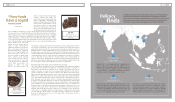Sennheiser 2009 Annual Report Download - page 21
Download and view the complete annual report
Please find page 21 of the 2009 Sennheiser annual report below. You can navigate through the pages in the report by either clicking on the pages listed below, or by using the keyword search tool below to find specific information within the annual report.
40 GOURME T TINKER
The ocean is a long way off – and then again … The waiter brings it to the table ensconced
in a giant conch shell perched on a wooden display box with a glass lid. In an old inn west
of London, oysters and baby eel are served in sea foam and sand; sea urchins and sea
spray, algae and flotsam. “My ocean is different than yours,” says one guest to another as he
pulls the hidden headphones out of the shell. The whispers and giggling begin to disappear as
guests insert the small white earbuds and lose themselves in the sound of waves rolling over the
beach, and the melancholy song of the seagulls and the sea breeze. The soundscape is
deceptively real. As guests close their eyes, they forget that the sea is rushing in from an iPod
Nano hidden in the spire of the conch shell. The sounds transport them from the tables of The
Fat Duck in Bray, England, to the beaches of Mykonos or Hawaii. The man responsible for their
teleportation is one of the finest chefs
in the world. But, despite his three
Michelin stars, 46-year-old Englishman
Heston Blumenthal shows no sign of pre-
tense or celebrity posturing. His stocky
build and shaved head with reddish-blonde
nubs make him look more like a striker on
an English football team. Self-educated
and with a boyish accent, only his designer
glasses give him away.
A menu eccentric and off-the-wall
As a young man, Blumenthal was impressed
by a book he read by Harold McGee: On
Food and Cooking. Since this revelation, his
epicurean coupling of stove top and
laboratory has given rise to such breath-
taking dishes as sardine sorbet and
cauliflower chocolate. Some call it mole-
cular gastronomy, but to Blumenthal it is a
passion for uncovering the promise of
multisensory perception. “Eating is the
only activity that uses all the senses,” says
Blumenthal. Sight, smell, taste, texture and
sound. “Intensifying the senses casts a
spell over the culinary experience.”
Professor Charles Spence, an experimental
psychologist at Oxford University, helped
him break the magician’s code. His Cross-
modal Research Laboratory is impressive:
“Every surface was covered in a jumble of
cables, connectors, headphones and sound
mixers,” says Blumenthal. To make his point, Spence gave him headphones, microphone and a
package of potato chips. “Nibble away!” Spence recorded Blumenthal as he crunched on the
chips and then played the sound back over the headphones. Depending on how the psychologist
adjusted the sound, Blumenthal’s perception of crispness modulated. It had the same effect on
carrots. “Amplifying the sound can increase the perception of crispness by 15 percent,”
says Spence. An effect he has been able to measure: among test subjects, the sense of crispness
improved by up to 10 percent. Since that first meeting almost ten years ago, the chef
and psychologist have become a successful team, experimenting together, publishing scientific
papers and advising major food producers. “Heston is very modest and didn’t learn much
A bowl full of delight served on rock salt:
oysters with passion fruit jelly,
horseradish cream and lavender (above)
A fabulous creation:
jelly of quail,
langoustine cream
and parfait of foie
gras (right)
Sweet moments for the connoisseur:
carrot and orange lollipops (below)
“Eating is the only
activity that uses
all the senses.”
HE ST O N BL UME NT HA L
























